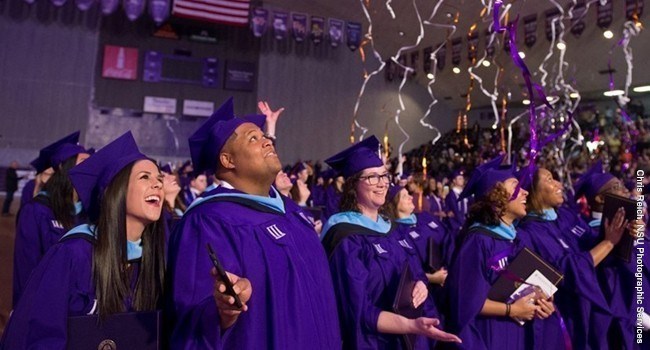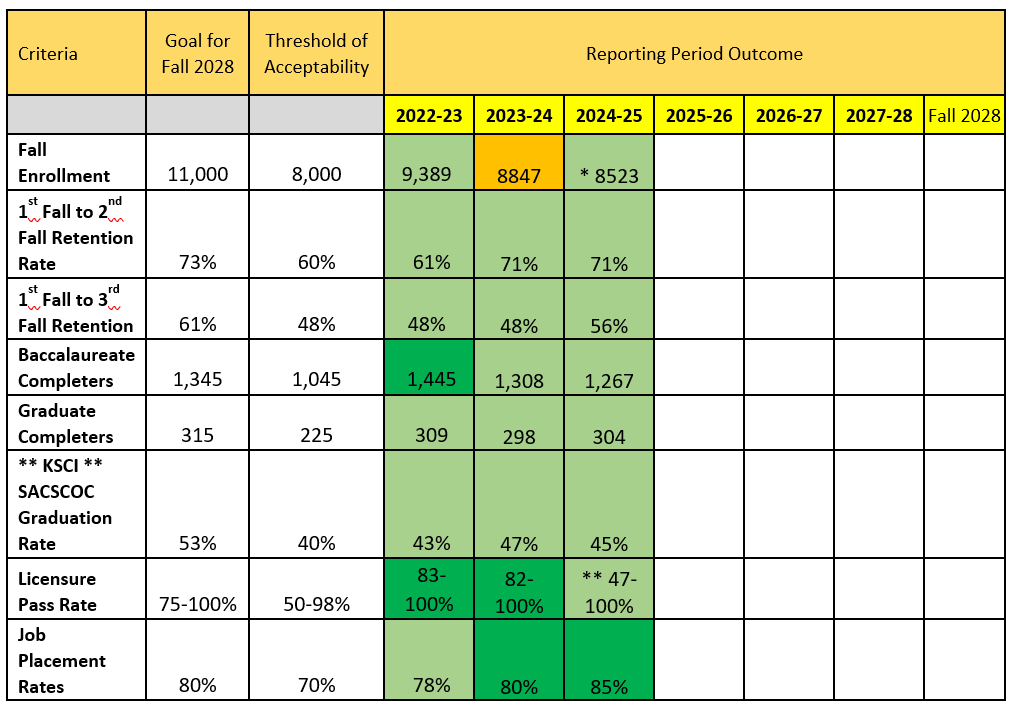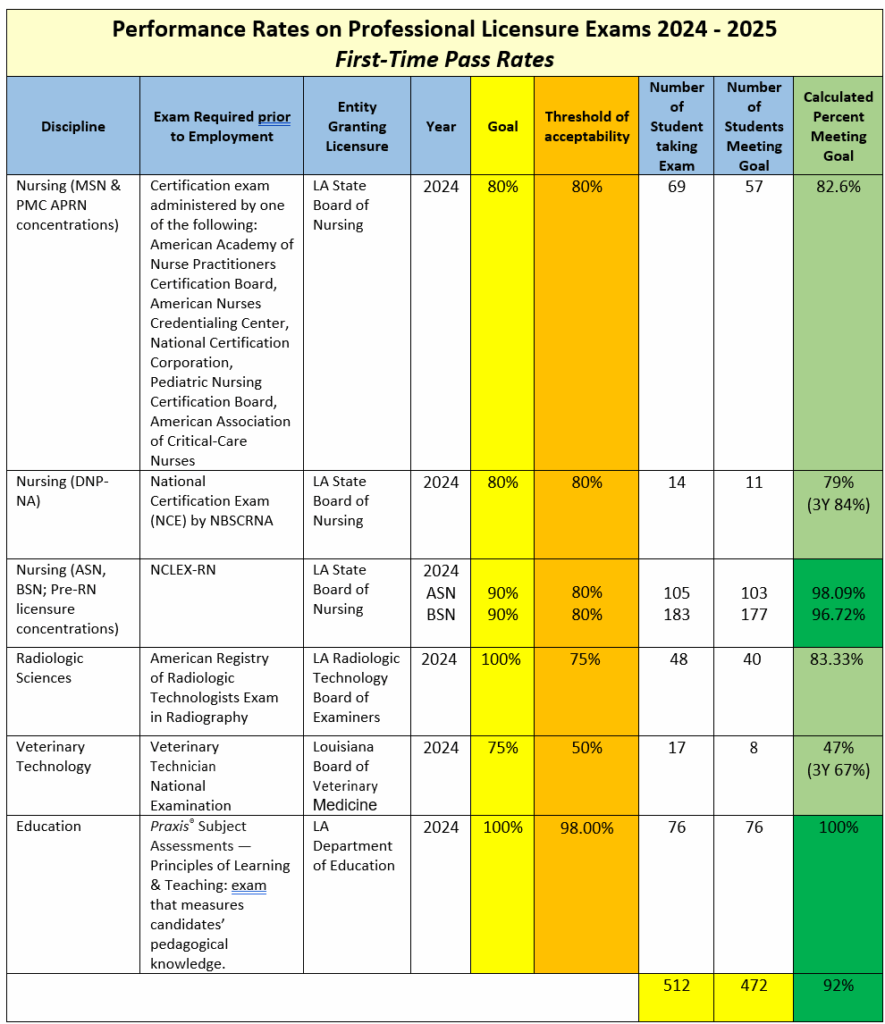Mission
Northwestern State University is a responsive, student-oriented institution committed to acquiring, creating, and disseminating knowledge through innovative teaching, research, and service. With its certificate, undergraduate, and graduate programs, Northwestern State University prepares its increasingly diverse student population to contribute to an inclusive global community with a steadfast dedication to improving our region, state, and nation.
Vision
Northwestern State University will become the nation’s premier regional university through the innovative delivery of transformative student learning experiences that prepare graduates for life and career success.
Northwestern measures student success related to specific components of its mission: “Northwestern State University prepares its increasingly diverse student population to contribute to an inclusive global community with a steadfast dedication to improving our region, state, and nation.” The University examines appropriate criteria concerning enrollment, retention rates, graduation rates, completers, licensure, and placement rates to document successful student achievement. These criteria align with a student’s time at Northwestern. The SACSCOC Graduation rate definition serves as Northwestern’s Key Student Completion Indicator (KSCI). Northwestern measures student achievement inclusive of all instructional sites and modes of delivery annually as part of its ongoing, integrated, institutional effectiveness process. This process evaluates how well it is achieving its mission, progressing towards its vision, and adhering to its values. The criteria developed by the University’s Strategic Planning Team serve as key indicators of mission success. As such, the criteria are integrated into the University’s Strategic Plan and the assessment of that plan.
The selected criteria allow the University to compare its outcomes to peer regional institutions and state and federal standards. These efforts result in deliberate measures of student achievement, which demonstrate the institution’s compliance with SACSCOC CR 8.1, its commitment to meeting the performance indicators monitored by the University of Louisiana System (ULS) and the Louisiana State Board of Regents (BOR), and mission accomplishment to its stakeholders.
Source: https://www.nsula.edu/oir/studentachievement/
* AC 2024-2025 Threshold of Acceptability adjusted based on twenty years of historical enrollment data. Before adjustment, the Threshold of Acceptability was 9,000. Source: NSU Factbook.
** Northwestern’s overall first-time pass rate is 92% (472/512). Nursing (DNP-NA) 79% (11/14), three-year average 84%. Nursing (MSN-NP) 89% (70/79), three-year average 86%. Vet Tech 47% (8/17), three-year average 67%.
Northwestern disaggregates each criterion by gender, ethnicity, socioeconomic status, and age. The disaggregation categories align with the university mission, the University of Louisiana Strategic Framework, and the Board of Regents Master Plan, all of which strive to increase educational access for all citizens of Louisiana.
A standardized approach describes each criterion. Each is defined with the source noted, the specific application to Northwestern provided, the goal for Fall 2028, and the target and outcome identified.
Fall Enrollment
The number of students enrolled in the fall at postsecondary institutions. Students reported are those enrolled in courses creditable toward a degree or other recognized postsecondary credential; students enrolled in courses that are part of a vocational or occupational program, including those enrolled in off-campus or extension centers; and high school students taking regular college courses for credit. IPEDS Glossary Definition
Goal. 11,000 Fall 2028.
Outcome. 8,523 Students for Fall 2024.
1st Fall to 2nd Fall Retention Rate
A measure of the rate at which students persist in their educational program at an institution expressed as a percentage. For four-year institutions, this is the percentage of first-time bachelor’s (or equivalent) degree-seeking undergraduates from the previous fall who are again enrolled in the current fall. IPEDS Glossary Definition
Goal. 73.0% – Retained from Fall 2027 to Fall 2028.
Outcome. 71.0% – Retained from Fall 2023 to Fall 2024.
1st Fall to 3rd Fall Retention rate
A measure of the rate at which students persist in their educational program at an institution expressed as a percentage. For four-year institutions, this is the percentage of first-time bachelor’s (or equivalent) degree seeking undergraduates students’ retention to the 3rd Fall from the cohort established for the 1st Fall-to-2nd Fall Retention rate metric. IPEDS Glossary
Goal. 61.0% – Retained from Fall 2027 to Fall 2028.
Outcome. 56.0% – Retained from Fall 2022 to Fall 2024.
Baccalaureate Completers / Grad Completers
A student who receives a degree, diploma, certificate, or other formal award. In order to be considered a completer, the degree/award must be conferred. IPEDS Glossary Definition
Goal – Baccalaureate Completers. 1,345 in Academic Year 2027-2028.
Outcome – Baccalaureate Completers. 1,267 in Academic Year 2023-2024.
Goal – Graduate Completers. 315 in Academic Year 2027-2028.
Outcome – Graduate Completers. 304 in Academic Year 2023-2024.
Graduation Rate
(Note. The SACSCOC Graduation rate serves as Northwestern’s Key Student Completion Indicator, KSCI). The SACSCOC Graduation rate is calculated based on the Annual Profile information (cohort size and number receiving a degree) that institutions provide to the Commission (as of spring 2018). SACSCOC Definition
Goal. 53% in Academic Year 2027-2028 (Fall 2020 cohort).
Outcome. 45% Academic Year 2023-2024 (Fall 2017 cohort).
Licensure
To receive, to apply to take or to take the examination required to receive, a local, State, or Federal license, or a nongovernmental certification required as a precondition for employment, or to perform certain functions in the States in which the educational program is offered, or to meet additional conditions that the institution knows or reasonably should know are generally needed to secure employment in a recognized occupation for which the program is represented to prepare students. Federal Regulation 34 CFR 668.50 Effective May 26, 2019
Source: Louisiana Board of Nursing, Radiologic Technology Board of Examiners, the Board of Veterinary Medicine, and the Department of Education. Northwestern’s overall first-time pass rate is 92% (472/512). Nursing (DNP-NA) 79% (11/14), three-year average 84%. Nursing (MSN-NP) 89% (70/79), three-year average 86%. Vet Tech 47% (8/17), three-year average 67%. Detailed Licensure Data is provided for AC 2024-2025.
Placement Rate
Placement rate is defined using the standards for career outcome rates approved by the National Association of Colleges and Employers (NACE) in their Standards and Protocols for the Collection and Dissemination of Graduating Students Initial Career Outcomes Information for Undergraduates. As such, the placement rate for this report will include the following graduate outcomes: employed, continuing their education, in the military, and volunteering within six months of graduation. Each year’s graduating class includes those students who complete degrees between the periods of July 1 to June 30 each year, a time consistent with degree completion reporting requirements established by the National Center for Education Statistics’ Integrated Postsecondary Education Data System (IPEDS) program. NACE Definition
The 2023-2024 FDS yielded the following results:
- 84.6% Working, Continuing Education, Military or Volunteering (+4.6% from 2022-2023)
- 15.4% Still looking for employment
- 0% Not seeking employment
The breakdown by graduation cohort is in the chart below:
Goal. Placement rate of 80% by 2027-2028.
Outcome. 84.6% in fall 2024.
The student achievement criteria outlined above guide the institution and ensure it is meeting its mission to “prepare its increasingly diverse student population to contribute to an inclusive global community with a steadfast dedication to improving our region, state, and nation.” When benchmarks are not consistently met, plans for improvement are devised, implemented, and re-analyzed to support continuous improvement.






